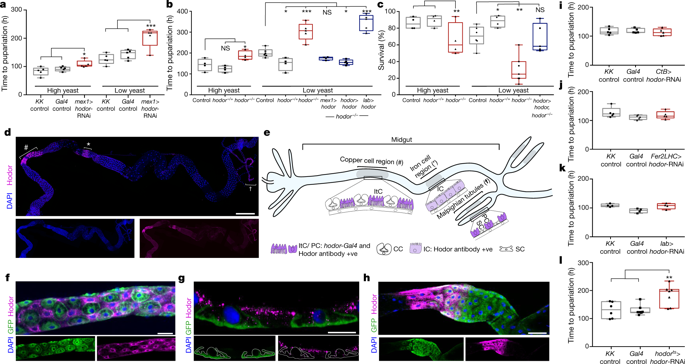Nature ( IF 64.8 ) Pub Date : 2020-03-18 , DOI: 10.1038/s41586-020-2111-5 Siamak Redhai 1, 2 , Clare Pilgrim 1, 2 , Pedro Gaspar 1, 2 , Lena van Giesen 3 , Tatiana Lopes 1, 2 , Olena Riabinina 1, 2, 4 , Théodore Grenier 5 , Alexandra Milona 1 , Bhavna Chanana 1, 2 , Jacob B Swadling 1, 2 , Yi-Fang Wang 1 , Farah Dahalan 6, 7 , Michaela Yuan 8 , Michaela Wilsch-Brauninger 8 , Wei-Hsiang Lin 9 , Nathan Dennison 6 , Paolo Capriotti 6 , Mara K N Lawniczak 7 , Richard A Baines 9 , Tobias Warnecke 1, 2 , Nikolai Windbichler 6 , Francois Leulier 5 , Nicholas W Bellono 3 , Irene Miguel-Aliaga 1, 2

|
In cells, organs and whole organisms, nutrient sensing is key to maintaining homeostasis and adapting to a fluctuating environment1. In many animals, nutrient sensors are found within the enteroendocrine cells of the digestive system; however, less is known about nutrient sensing in their cellular siblings, the absorptive enterocytes1. Here we use a genetic screen in Drosophila melanogaster to identify Hodor, an ionotropic receptor in enterocytes that sustains larval development, particularly in nutrient-scarce conditions. Experiments in Xenopus oocytes and flies indicate that Hodor is a pH-sensitive, zinc-gated chloride channel that mediates a previously unrecognized dietary preference for zinc. Hodor controls systemic growth from a subset of enterocytes—interstitial cells—by promoting food intake and insulin/IGF signalling. Although Hodor sustains gut luminal acidity and restrains microbial loads, its effect on systemic growth results from the modulation of Tor signalling and lysosomal homeostasis within interstitial cells. Hodor-like genes are insect-specific, and may represent targets for the control of disease vectors. Indeed, CRISPR–Cas9 genome editing revealed that the single hodor orthologue in Anopheles gambiae is an essential gene. Our findings highlight the need to consider the instructive contributions of metals—and, more generally, micronutrients—to energy homeostasis.
中文翻译:

肠道锌传感器调节食物摄入和发育生长
在细胞、器官和整个生物体中,营养感应是维持体内平衡和适应波动环境的关键1。在许多动物中,营养传感器存在于消化系统的肠内分泌细胞中。然而,对于它们的同胞细胞——吸收性肠细胞1中的营养感应知之甚少。在这里,我们在黑腹果蝇中使用遗传筛选来识别 Hodor,这是一种肠细胞中的离子型受体,可维持幼虫的发育,特别是在营养缺乏的条件下。非洲爪蟾的实验卵母细胞和果蝇表明,Hodor 是一种 pH 敏感的锌门控氯化物通道,可调节以前未被认识的对锌的饮食偏好。Hodor 通过促进食物摄入和胰岛素/IGF 信号传导来控制肠细胞子集(间质细胞)的全身生长。虽然 Hodor 维持肠腔酸度并抑制微生物负荷,但其对全身生长的影响是由间质细胞内 Tor 信号传导和溶酶体稳态的调节引起的。Hodor 样基因是昆虫特异性的,可能代表控制疾病媒介的目标。事实上,CRISPR-Cas9 基因组编辑揭示了冈比亚按蚊中的单一hodor直系同源物是必不可少的基因。我们的研究结果强调需要考虑金属——更一般地说,微量营养素——对能量稳态的有益贡献。



























 京公网安备 11010802027423号
京公网安备 11010802027423号